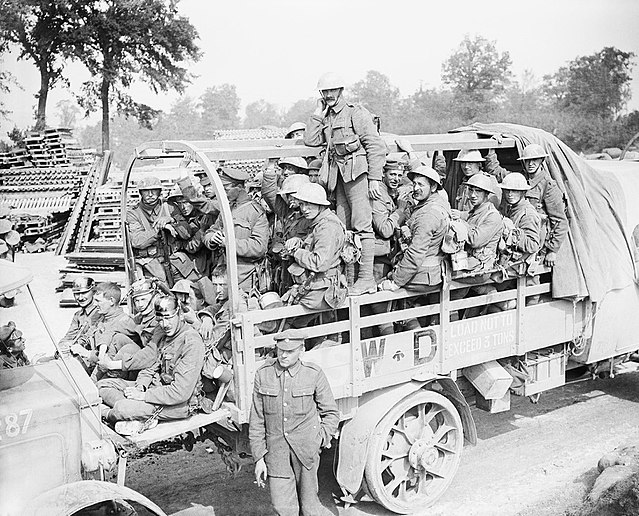The Battle of Ginchy took place on 9 September 1916 during the Battle of the Somme, when the 16th (Irish) Division captured the German-held village. Ginchy is 0.93 mi (1.5 km) north-east of Guillemont, at the junction of six roads, on a rise overlooking Combles, 2.5 mi (4 km) to the south-east. After the conclusion of the Battle of Guillemont on 6 September, XIV Corps and XV Corps were required to complete the advance to positions which would give observation over the German third position. The advance was to make ready for a general attack in mid-September, for which the Anglo-French armies had been preparing since early August.
60-pounder battery, Contalmaison
German 15 cm sFH 13 heavy field howitzers
Troops advance, Battle of Ginchy
Air reconnaissance camera, operated by the pilot of a B.E.2c, 1916
The 16th (Irish) Division was an infantry division of the British Army, raised for service during World War I. The division was a voluntary 'Service' formation of Lord Kitchener's New Armies, created in Ireland from the 'National Volunteers', initially in September 1914, after the outbreak of the Great War. In December 1915, the division moved to France, joining the British Expeditionary Force (BEF), under the command of Irish Major General William Hickie, and spent the duration of the war in action on the Western Front. Following enormous losses at the Somme, Passchendaele and Ypres, the 16th (Irish) Division required a substantial refit in England between June and August 1918, which involved the introduction of many non-Irish battalions.
Crowd gathered in College Green for the unveiling of a Celtic Cross in memory of the 16th (Irish) Division, Armistice Day, 1924.
Men of the 16th (Irish) Division (possibly of the 47th Brigade) in a lorry going back for a rest after taking Guillemont, 3 September 1916. They are passing by the "Minden Post" on the Fricourt-Maricourt road, west-south-west of Carnoy. Note some soldiers wearing captured German pickelhaubes and feldmutzes. Two soldiers clearly display cap badges of the Royal Irish Regiment.
Cardinal Francis Bourne, the Head of the Catholic Church in England and Wales, and Major-General William Hickie, General Officer Commanding (GOC) 16th (Irish) Division, inspecting troops of the 8/9th (Service) Battalion, Royal Dublin Fusiliers at Ervillers, 27 October 1917.
Headquarters of the 49th Infantry Brigade: the Brigade Major, the Education Officer and the Interpreter. January 1919.








